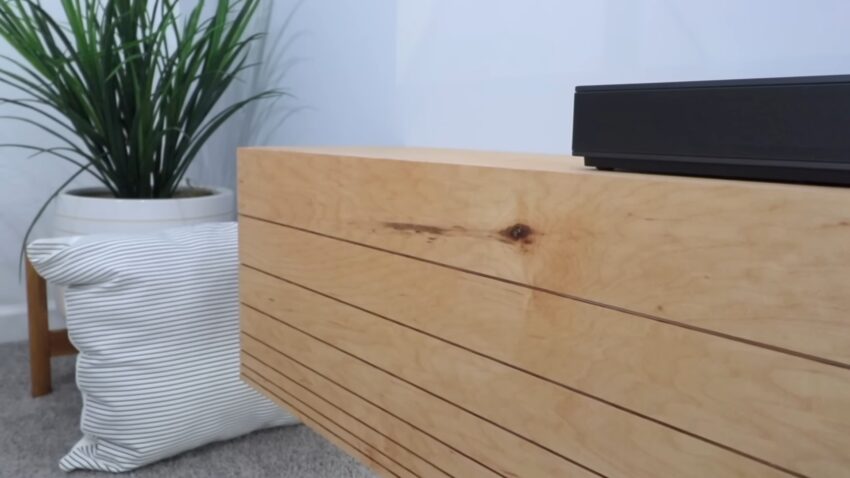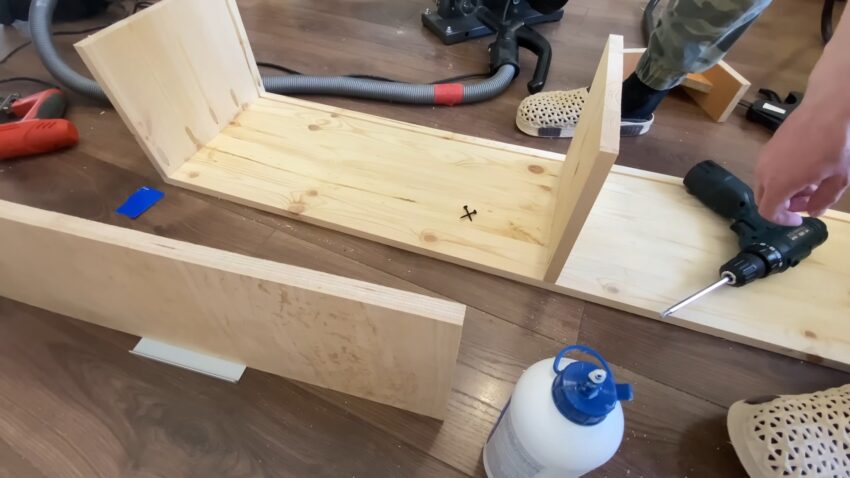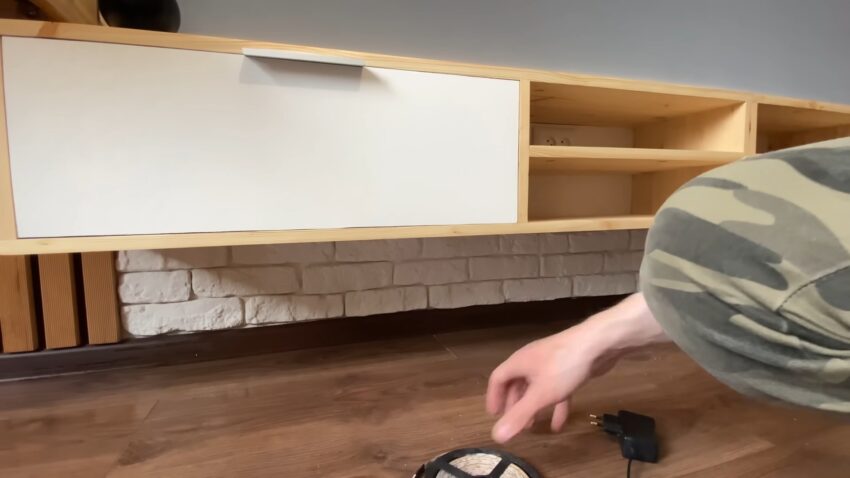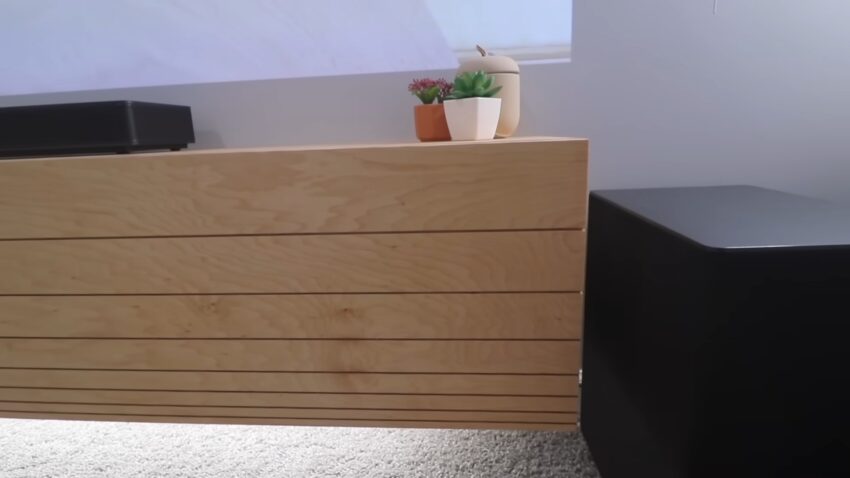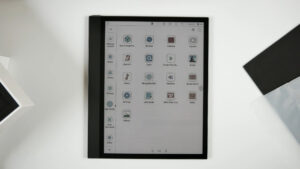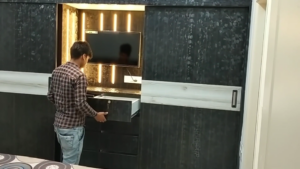When I first moved into my apartment, I was faced with the challenge of maximizing space without compromising on aesthetics. The bulky TV cabinet I inherited from my previous setup seemed out of place in my new, modern living room. That’s when I stumbled upon the concept of a floating TV stand.
Not only did it promise a sleek look, but it also seemed like the perfect solution to free up some much-needed floor space. My little DIY project, however, was a blend of research, trial, and a touch of error.
In this guide, I’ll share the insights I gained from my personal experience, combined with expert advice, to help you achieve a flawless setup.
Essential Tools and Materials
Before starting the installation process, it’s crucial to gather all necessary tools and materials. This ensures a smooth process and avoids unnecessary interruptions. To mount a floating TV and it’s stand, you’ll need some basic tools. These include:
- a stud finder
- a level
- a drill
- wall anchors (if studs aren’t available)
- a pencil for marking
- a tape measure.
Depending on the specific TV stand model, you might also need additional tools, so always refer to the manufacturer’s instructions.
Materials to Consider
The primary material you’ll be working with is the floating TV stand itself. However, you might also need wall anchors (especially if you’re not drilling into studs), screws appropriate for your wall type, and possibly spacers or washers.
Some TV stands come with mounting hardware, but it’s always a good idea to double-check the quality and consider purchasing sturdier alternatives if needed.
Step-by-Step Installation Guide
The whole process might seem daunting, but with the right steps, it’s a manageable task. Here’s a detailed guide to help you through the process.
1. Locating the Studs
The first step is to locate the studs in your wall using a stud finder. Studs are the vertical frames inside walls, and they provide the most secure anchor for heavy objects like a TV stand.
Move the stud finder horizontally across the wall, marking the center of each stud with a pencil. This will be where you drill.
2. Marking and Drilling
Once you’ve located the studs, hold the TV stand’s mounting bracket against the wall, ensuring it’s level. Mark the drilling points using a pencil. Drill pilot holes into the marked points.
If you’re not drilling into studs, you’ll need to insert wall anchors into these holes.
Securing the TV Stand
After drilling, the next step is to ensure that your TV stand is securely attached to the wall. This is crucial for the safety of your television and anyone around it.
Attaching the Bracket
With the pilot holes drilled (and wall anchors inserted if necessary), align the mounting bracket of the TV stand with the holes. Using the appropriate screws, secure the bracket to the wall.
Ensure that it’s tightly fastened and doesn’t wobble.
Mounting the TV Stand
Once the bracket is in place, you can attach the main body of the TV stand. This often involves hooking or sliding the stand onto the bracket. Ensure that it’s securely attached and can bear the weight of the TV.
Follow the manufacturer’s instructions closely during this step.
Tips for a Perfect Mount
While the basic steps are straightforward, there are nuances to mounting a floating TV stand that can make a significant difference in the outcome.
Ensuring Level Alignment
One of the most common issues people face is a crooked TV stand. To avoid this, always use a level when marking your drill points and when attaching the bracket. Check and double-check to ensure everything is perfectly horizontal.
Cable Management
A floating TV stand’s aesthetic appeal can be quickly diminished by messy cables. Plan your cable management in advance. Some TV stands come with built-in cable management systems.
If yours doesn’t, consider using cable clips, sleeves, or conduits to keep everything tidy.
FAQs
Can I mount a floating TV stand on a brick or concrete wall?
Yes, you can mount a floating TV stand on brick or concrete walls. However, you’ll need specialized masonry drill bits to drill holes into these hard surfaces. Additionally, you should use wall plugs or masonry anchors to ensure a secure fit.
Always ensure that the anchors and screws you use are designed for masonry applications.
What should I do if my wall studs don’t align with the mounting points on the TV stand?
If the wall studs don’t align with the mounting points, you can use a plywood board as a bridge. Mount a piece of plywood (that’s wider than the distance between the studs) securely to the studs.
Then, mount the TV stand onto the plywood. This provides a secure base and allows you to position the TV stand as desired.
How do I determine the maximum weight my wall can support?
The weight your wall can support largely depends on the type of wall and how the TV stand is mounted. Studs can generally support more weight than drywall alone. Check the specifications of the wall anchors or mounting hardware you’re using.
If unsure, consult with a professional or the hardware manufacturer. It’s always better to err on the side of caution.
Are there any aesthetic tips for choosing the right floating TV stand for my room?
Certainly! When choosing a floating TV stand, consider the overall decor and color scheme of your room. A minimalist, sleek design might suit modern interiors, while a wooden or rustic design might complement traditional homes.
Also, consider the size of the TV and the wall space. You don’t want the stand to overpower the room or look too small on a vast wall.
Can I add additional shelves or modify my floating TV stand after it’s mounted?
While it’s possible to modify or add shelves to some floating TV stands, it’s essential to consider the weight implications and the structural integrity of the stand. Any modifications might affect its weight-bearing capacity.
Always refer to the manufacturer’s guidelines and, if in doubt, consult with a professional.
How often should I check the stability of my mounted TV stand?
It’s a good practice to check the stability of your floating TV stand every few months, especially during the initial year after installation. Ensure that the screws are tight and that there’s no wobbling or signs of wear.
Over time, as you become confident in its stability, you can extend the check to once a year. Regular checks ensure the safety and longevity of your setup.
The Bottom Line
Having now enjoyed my floating TV stand for a while, I can confidently say that the effort put into mounting it was well worth the result. It’s transformed the way my living room looks and feels – spacious, modern, and uncluttered.
But beyond the aesthetics, the sense of accomplishment from a DIY project done right is unparalleled. I hope this guide has provided you with valuable insights and answers to make your project smoother. Remember, as with any project, patience, preparation, and a little bit of elbow grease go a long way.
Related Posts:
- How High to Mount Floating TV Stand: An In-Depth Guide
- From Romantic Movies to Action: An Overview of…
- ONKRON Mobile TV Stand Rolling Cart 2024 - Roll Your…
- Powered Speaker for Keyboard - Questions and Tips
- How big is a 20-inch TV? [cm & inches] Breaking Down…
- Optimizing Your Smart TV: 7 Top Tips for a Seamless…


